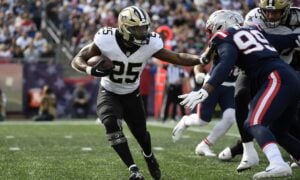Diary of an IDP Rookie: Midseason Report
 During the most recent offseason, I decided to take the daunting and exciting leap into the world of IDP fantasy football. This happened as one of my leagues added a few IDP starters to our lineups as well as the DLF staff starting an IDP league. I was definitely a little bit nervous coming into things, especially in the staff league, but I felt I was ready for the challenge and I’ve definitely enjoyed the experience!
During the most recent offseason, I decided to take the daunting and exciting leap into the world of IDP fantasy football. This happened as one of my leagues added a few IDP starters to our lineups as well as the DLF staff starting an IDP league. I was definitely a little bit nervous coming into things, especially in the staff league, but I felt I was ready for the challenge and I’ve definitely enjoyed the experience!
In order to help anyone else out that is thinking about taking the plunge, I decided to chronicle my approach in the IDP staff league to lay out a roadmap of things to do (or not to do!) if things went well. This started with my pre-draft plan as well as a post-draft look back at what happened during the draft. I’m happy to say that so far my plan has worked out rather well as I’m currently sitting at the top of the standings in the staff IDP league through the first ten weeks. Now that we are well into the season, I’m coming back to give some additional thoughts and musing about IDP leagues from the perspective of someone that is new to that arena. If you want to be super kind to me, you could maybe even call them insights into the world of IDPs from someone that has only a few months of experience.
I’ll be the first to admit some of these observations could be dead wrong as I have a rather limited sample size, but sometimes it takes a fresh view point to derive the small shreds of truth from things. My goal is that my experiences will help those of you that are taking or thinking of taking that first leap into IDPs in the near future.
On with the observations!
Observation #1: IDPs are by nature very inconsistent.
In general, I’m a fantasy owner who values consistency over just about anything else. I would much rather have the player who gets me 12-18 points every week than the one who posts five points one week and 35 the next. I don’t like the boom-or-bust style of player and I don’t like the injury prone players who will give you RB1 numbers for the six games they play a year. Some people find the huge ups and downs exciting, but I just find it frustrating and try to avoid it.
This preference for consistency made the switch to IDP leagues a little bit of a struggle at first. It wasn’t until I fully understood the nature of the IDP beast that I felt better. Because of how IDPs are scored and the nature of many positions, they are all going to be boom-or-bust. Your stud defensive lineman isn’t going to get one sack a game all season long. They might get two or three in one game and then nothing for four weeks. It would be a bit like playing in a touchdown only league on offense. It is just the way things are with IDPs. The only positions that come anywhere close to being an exception are strong safeties and middle linebackers. Even then, it depends on the game plan of the opponent a bit as they might have two tackles one week and ten tackles the next. This means staying true to the players and not chasing box scores is extremely important.
This inconsistency is also true from year to year. JJ Watt is the prime example of this if we look at his 2012 season to this season, but he is far from the only example. That isn’t to say that Watt is struggling, because he isn’t. He’s still a top 10 IDP in a lot of leagues and a top 3 defensive end. He just isn’t lapping the field like he was last year. Since IDPs are really only involved in plays when they get a chance to be, they are to some extent at the mercy of the other team. What I mean by this is that teams can throw/run away from certain defenders to avoid them or assign extra blockers to slow them down. When someone stands out as much as Watt did in 2012, teams actually game plan to limit his impact, which causes his production to drop. It isn’t like an offensive player where the team can manufacture touches. Defenders are forced to play the game that comes their way and sometimes the standouts help their teammates make the big play instead of making it themselves. Unfortunately, we don’t get fantasy points for our lineman that eats up three blockers while someone else on his team gets the sack.
Observation #2: Since things change so much from year to year and during the year, be very aggressive with the waiver wire especially early on.
One of the biggest breaks for my team this season has been some of the talent that I’ve added through the waiver wire. Even with large rosters of 44 players, there is an abundance of quality IDPs that are out there. Many of these players are young, talented and just about to get their break due to an injury or because they are beating out a less productive veteran. Often times these are second or third year players that failed to do much as a rookie (more on this later) or late round rookies that no one expected to earn a starting role.
By doing a little bit of homework and making some aggressive bids early in the season, I’ve been able to add numerous players that were on the cusp of breaking out and becoming IDP starters. My defensive pick-ups through the waiver wire include the likes of Dontari Poe, Sheldon Richardson, Sio Moore, Danny Trevathan, Paul Worrilow, Tracy Porter, Major Wright, Vincent Rey, and Duke Ihenacho. That’s a lot of names, most of them young and with increasing roles on their teams.
The fact that the waiver wire is so flush with talent due to the fact every team has at least 11 defensive starters has made me very willing to take some gambles with about half of my defensive bench. While none of these players are likely to be top five at their position, they are definitely good enough to be starters at least on bye weeks if not on normal weeks as well. A waiver add is much better than spending a draft pick or trading for someone who is just as inconsistent (see my first observation) and only marginally better in the long run.
Observation #3: Don’t fall in love with rookie IDPs.
This didn’t really occur to me until I started doing IDP leagues this year. On the offensive side of the ball, especially at the running back and wide receiver position, not much changes from college to the pros. You get the ball, and you try to run as far as you can without getting tackled. Now of course that is a little over simplified, but there is some truth to the statement. Defensive players are a whole different ball of wax because it isn’t really about what they do as much as it is about them playing their role in the system. A linebacker is one piece of the 11 man defensive machine. Much like a running back learning pass protection schemes, a wide receiver learning hot reads, or a tight end learning how to block the entire defensive game plan takes time for a rookie to learn. For that reason, it takes some time for the vast majority of rookies to make an impact.
I made the mistake this year of spending middle round picks on IDP rookies, expecting to watch them take over and produce. At the time, I didn’t realize exactly what kind of time commitment we were talking about for them to learn their role. In most cases, there are veteran players (sometimes last year’s rookies) that are still young and equally talented to those rookies that could be taken in their place or even several rounds later. There are also going to be a fair number of the highly drafted rookies that end up being busts, much like on the offensive side of the ball. The elite players are of course exceptions to this rule, but overall I think it is best to just stay away from the rookies given the price tag that they often command due to the rookie fever during offseason drafts.
Observation #4: There is a big difference between NFL star and IDP star.
One of the most difficult items to first adjust to was just because a defensive player is a big name in real life doesn’t mean they are a highly prized IDP asset. There are of course a few that are both NFL stars and IDP stars but often times there is a disconnect between the two. The easy thing to do for a novice IDP owner like myself is to gravitate towards the names that you already know from watching football each and every Sunday (as well as Thursdays, Mondays, and the occasional Saturday!). The problem with that is that lesser known players like Lavonte David and Chad Greenway are much more productive IDP assets than better known players like Brian Cushing. Breaking away from the familiar is difficult, but extremely important if you want to succeed.
The other side of this coin is making sure that you consider their real life production as well. Sometimes a player with average talent is in a great situation which is driving their production. Even if they are a great IDP asset, their value might be short lived if fantasy doesn’t match reality. It won’t be long before the team finds a player with a bit more skill to fill their shoes. This shouldn’t be a surprise though as the same thing happens on the offensive side of the ball. An average running back can put up great stats in a high powered offense, but eventually the team might upgrade leaving your fantasy roster high and dry. It is important to realize that this happens on defense as well, even more often than it does on offense.
Summary
Those are the big four that stand out to me at the current point in time. You need to realize IDPs are inconsistent, the waiver wire is your friend, rookies often aren’t what they are cracked up to be and there is a difference between fantasy and reality. If you are an experienced IDP owner, feel free to share your thoughts and opinions in order to help those that are new to this world adjust more easily. I’ll be back after the season is over and make an attempt at some final conclusions about my first venture into the land of IDPs.
- Final 2021 Pre-Draft Rookie Mock: Round Three - April 28, 2021
- Final 2021 Pre-Draft Rookie Mock: Round Two - April 26, 2021
- Final 2021 Pre-Draft Rookie Mock: Round One - April 25, 2021


































































